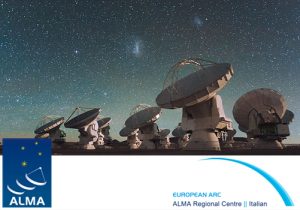 The Atacama Large Millimeter/submillimeter Array (ALMA) is one of the largest international telescopes to date. Its imaging and spectroscopic capabilities, together with unprecedented sensitivity and resolution at frequencies 30 GHz – 1 THz allow the study of the molecular gas and dust in the Universe. The Italian node of the European ALMA Regional Centre (ARC) at IRA provides technical and scientific support to the astronomical community.
The Atacama Large Millimeter/submillimeter Array (ALMA) is one of the largest international telescopes to date. Its imaging and spectroscopic capabilities, together with unprecedented sensitivity and resolution at frequencies 30 GHz – 1 THz allow the study of the molecular gas and dust in the Universe. The Italian node of the European ALMA Regional Centre (ARC) at IRA provides technical and scientific support to the astronomical community.
Staff: M. Bonato, E. Liuzzo, N. Marchili, M. Massardi, R. Paladino, K. Rygl
Collaborators: I. Baronchelli, J. Brand
ALMA is located at one of the driest locations in the world, the Atacama desert in the Chilean Andes at an altitude of about 5000 m. Its 66 antennas are distributed among a Main Array, of fifty 12-m diameter antennas, the Atacama Compact Array of twelve 7-m antennas packed closely together, and four 12-m antennas of the Total Power Array. The maximum distance between antennas reaches 16 km, thus allowing observations at resolutions down to 6 milliarcseconds. Scientific observations with ALMA started in September 2011. User support is provided by the ALMA Regional Centres in East Asia, North America and Europe. The European ARC is set up as a distributed network of six regional nodes and a center of expertise (CoE), coordinated by ESO. They primarily provide assistance to their own communities, but also serve external users who wish to take advantage of the expertise and experience of a particular node.
The Italian ARC node is hosted by the Institute for Radioastronomy in Bologna and offers support with proposal preparation and submission, tracking of accepted ALMA projects, data reduction with the CASA package. ALMA archive mining, polarimetry and mm-VLBI with ALMA are the three areas of expertise of the Italian node. The Italian ARC also investigates new techniques of data reduction and handling and is heavily involved in the development of the ALMA science data archive. It organizes seminars, tutorials and workshops to inform and train the Italian community and to stimulate scientific discussion and collaborations. ARC personnel is involved in teaching and supervising students. The Italian ARC researchers are involved in several (sub-) millimeter scientific projects covering different topics (from galactic and local-Universe studies to high-redshift galaxies and cosmology), and offer general scientific support on their specific area of expertise for continuum and spectroscopic observations.
At IRA, the ARC node can accommodate visitors for face-to-face support and visits. Visitors can connect to a dedicated computer server, to access the data and run the CASA data reduction software locally. The ARC node is connected to the national and European Research and Education networks through a high-speed optical fibre link, allowing fast data transfer (10 Gbit/sec). External users can also access the ARC node cluster facilities for a certain period of time, for ALMA- and CASA-related issues.
More info on the Italian ARC-node website and on the ALMA Science Portal at ESO.
Credits
Main button and Figure: C. Malin (ESO)
